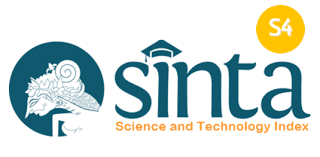IMPLEMENTATION OF AUTOMATIC HANDWASHING WAIST FOR COVID-19 PREVENTION
Abstract
Abstrak
Penyebaran Corona Virus (COVID-19) di dunia yang sangat cepat perlu diikuti dengan tindakan pencegahan berupa protolol kesehatan, salah satunya yaitu mencuci tangan. Tujuan kegiatan pengabdian masyarakat ini adalah mengimplementasikan wastafel otomatis di TK. ABA 67 yang terletak di Kelurahan Morokrembangan Kota Surabaya sebagai sarana pencegahan penularan penyakit wabah Covid-19. Metode yang digunakan dalam pelaksanaan kegiatan pengabdian masyarakat ini adalah pertama pembuatan alat cuci tangan yang bisa mengalirkan air dan sabun secara otomatis. Kedua adalah memberikan edukasi kepada 30 peserta yang terdiri atas guru, karyawan, dan wali murid TK mengenai pentingnya protokol kesehatan untuk mencegah Covid-19. Hasil dari kegiatan kegiatan pengabdian masyarakat ini adalah 90 % peserta memahami mengenai bahayanya penyakit virus corona, cara penyebaran, serta cara penanggulangannya yaitu melalui adaptasi kebiasaan untuk cuci tangan dengan air dan sabun, sedangkan sisanya yaitu 10% perlu diberikan edukasi lebih lanjut. Selain itu pada akhir acara dilakukan penyerahan alat wastafel otomatis untuk TK. ABA 67 Kelurahan Morokrembangan Kota Surabaya sehingga dapat dipergunakan dalam menyambut datangnya pembelajaran tatap muka.
Kata Kunci: Covid-19, protokol kesehatan, pnemonia, sensor otomatis
Abstract
The very rapid spread of Corona Virus (COVID-19) in the world needs to be followed by preventive measures in the form of health protocols, one of which is washing hands. The purpose of this community service activity is to implement an automatic sink in kindergarten. ABA 67 is located in Morokrembangan Urban Village, Surabaya City as a means of preventing the transmission of the Covid-19 outbreak. The method used in the implementation of this community service activity is the first to manufacture a hand washing device that can drain water and soap automatically. The second is to provide education to 30 participants consisting of teachers, employees, and guardians of kindergarten students about the importance of health protocols to prevent Covid-19. The result of this community service activity is that 90% of participants understand the dangers of the Coronavirus, how it is spread, and how to overcome it, namely through the adaptation of the habit of washing hands with soap and water. the remaining 10% needs to be given further education. Besides, at the end of the event, an automatic sink device was handed over to the kindergarten. ABA 67 Kelurahan Morokrembangan, Surabaya City so that it can be used in welcoming face-to-face learning.
Keyword : Covid-19, health protocol, pneumonia, automatic sensor
Keywords
Full Text:
PDFReferences
I. Widyasari, I. Matussilmiyuliyani, and S. Nurjana, "Penguatan Peran Masyarakat dalam Upaya Preventif Terhadap Covid-19 di Dusun Bercak Kecamatan Mungkid Kabupaten Magelang" COMMUNITY Empower., vol. 6, no. 1, pp. 29-34, 2021.
Yuliana, "Wellness and Healthy Magazine" Parq. los afectos. Jóvenes que cuentan, vol. 2, no. February, pp. 124-137, 2020.
Y. Yi, P. N. P. Lagniton, S. Ye, E. Li, and R. H. Xu, "COVID-19: What has been learned and to be learned about the novel coronavirus disease" Int. J. Biol. Sci., vol. 16, no. 10, pp. 1753-1766, 2020.
L. R. V. Sinaga, S. A. Munthe, and H. A. Bangun, "Sosialisasi Perilaku Cuci Tangan Pakai Sabun di Desa Sawo Sebagai - Bentuk Kepedulian Terhadap Masyarakat Ditengah Mewabahnya Virus Covid-19" vol. 1, no. September, pp. 19-28, 2020.
R. Djalante et al., "Review and analysis of current responses to COVID-19 in Indonesia: Period of January to March 2020" Prog. Disaster Sci., vol. 6, p. 100091, 2020.
C. I. Lestari, C. Esty Pamungkas, S. Mardiyah WD, and B. Masdariah, "Penyuluhan Tentang Cuci Tangan Pakai Sabun (Cpts) Untuk Mencegah Peyebaran Coronavirus (Cov) Di Wilayah Kerja Puskesmas Karang Pule" SELAPARANG J. Pengabdi. Masy. Berkemajuan, vol. 4, no. 1, p. 370, 2020.
Nuruzzaman and Syahrul, "Analisis Risiko Kejadian Demam Tifoid Berdasarkan" J. Berk. Epidemiol., no. July, pp. 74-86, 2016.
M. Burton, E. Cobb, P. Donachie, G. Judah, V. Curtis, and W. P. Schmidt, "The effect of handwashing with water or soap on bacterial contamination of hands" Int. J. Environ. Res. Public Health, vol. 8, no. 1, pp. 97-104, 2011.
P. Lumbal, D. I. Bagian, N. Rsup, and R. D. K. Manado, "EVALUATION OF EFFECTIVENESS OF WASHING PROCEDURE ON puncture adalah ( lumbar menjadi acuan jika di masa yang akan dikerjakan evaluasi memasukkan jarum ke dalam ruang subaraknoid yang steril ( Gambar 1 ). Tindakan ini harus dikerjakan secara steril untuk m" Sinaps, vol. 1, no. 1, pp. 47-66, 2018.
I. Anshory, D. Hadidjaja, and R. B. Jakaria, "Bldc Motor : Modeling and Optimization Speed Control Using Firefly Algorithm" Dinamik, vol. 25, no. 2, pp. 51-58, 2020.
B. Hu, H. Guo, P. Zhou, and Z. L. Shi, "Characteristics of SARS-CoV-2 and COVID-19" Nat. Rev. Microbiol., no. December, 2020.
B. Reppi et al., "Pelaksanaan Protokol Kesehatan Corona Virus Disease 2019 Oleh Masyarakat di Kabupaten Minahasa Tenggara" vol. 1, no. March, pp. 33-39, 2020.
H. A. Aboubakr, T. A. Sharafeldin, and S. M. Goyal, "Stability of SARS-CoV-2 and other coronaviruses in the environment and on common touch surfaces and the influence of climatic conditions: A review" Transbound. Emerg. Dis., no. April, pp. 1-17, 2020.
W.Zhou,Wang_Zhou_Nanshan_Zhong_Qiang_Wang_KeHu_ZaiqiZhangCoronavirus_Prevention Handbook_101_Science-Based_Tips_That_Could_Save_Your_Life-Skyhorse.pdf. Hubei Science and Technology Press, Wuhan, China, 2020.
R. Ikawaty, "Dinamika Interaksi Reseptor ACE2 dan SARS-CoV-2 Terhadap Manifestasi Klinis COVID-19" KELUWIH J. Kesehat. dan Kedokt., vol. 1, no. 2, pp. 70-76, 2020.
S. Rahman and T. Bahar, "COVID-19: The New Threat" Int. J. Infect., vol. 7, no. 1, pp. 1-6, 2020.
DOI: https://doi.org/10.35971/jjhsr.v3i2.9798
Refbacks
- There are currently no refbacks.

This work is licensed under a Creative Commons Attribution-ShareAlike 4.0 International License.
Jambura Journal of Health Sciences and Research is licensed under a Creative Commons Attribution-ShareAlike 4.0 International License
</p



_.png)




_edit.png)




